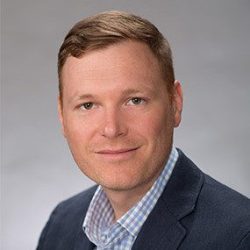
In his role, he helps customers prepare to implement their software, as well as overseeing the implementation of it. He has also lived through the implementation and was instrumental in creating a case study by Certinia about the benefits the company saw. This interview asks some of the questions whose answers were omitted from the case study rather than repeating it.

Many will have heard of the global vendor, Avalara, but I asked Tyler to give the 30-second pitch for the company he works for. He replied, “Everyone is selling things online. We are now an internet-based eCommerce world. Our founders anticipated this.
“Every time somebody sells something to someone in a different location, they have to charge that location’s sales tax, collect that money, and file a return with that local jurisdiction at the end of the month, or end of the quarter, the end of the year. Avalara helps automate that entire process.”
In the beginning
When and how did Avalara decide to deploy the Certinia PSA solution?
“I joined the company as part of an acquisition. After more acquisitions, we consolidated professional services under one leader. It became very difficult to manage our business because they all had inherited or brought their own way of doing things. We had acquisitions that built their own project management software; some used basic tools like Microsoft Access or Excel.
“Other acquisitions that had been leveraging other SaaS-based project management tools. We have used Clarizen and Smartsheet for several years. We’ve recognised, though, that you’ve got to close the books every month for any professional service team or any business in general. As you go through the process of closing the books on four or five different systems, you’re going to go through four or five times the amount of effort or time it takes versus if you only had one system.
“All of those tools bring their pros and cons. You can’t look at your practice at a uniform level and measure them all the same way because all the output from those systems and tools are different.
“Avalara recognised that we had to get on to a common platform or system. We cast a pretty wide net, looking at a lot of different products and vendors. We looked at our own tools and asked if we should consolidate them all into one. We didn’t go down that path.
“Our company was already living out of Salesforce, and we said, wouldn’t it be a natural fit if we were also managing our projects in Salesforce? That gave Certinia a huge leg up in our evaluation, the fact that it’s a natural extension of Salesforce.”
What happened next?
Flora recalls that sometime around 2018/19, the company started a six-month evaluation period of Certinia. Avalara purchased the PSA module and the revenue recognition (now part of Services Revenue Management) as it would enable them to monitor revenue in real-time.
Flora then spoke about the implementation, saying, “We probably went live with the first area of professional services within six months, and then we started adding service lines about every two months after that. After about a full year, we pretty much migrated our entire business into the system.”
Who implemented the solution?
“We worked with the Certinia partner, VFP. They are fantastic to work with. They came on-site and helped us get an understanding. The hardest part of the journey is just understanding what’s possible with the system. They really did a good job of talking to me; let’s pick a service line; let’s choose an easier one. Let’s get some quick wins in this process.
“One recommendation or best practice that I have is to choose one service line that you need to get into the system for an early win. That’s also going to help with adoption, help with getting other people bought into the process of seeing what’s possible. It’s that learning curve or gap with a new system that you have to close.
“Then, as we iterated, they were instrumental in building out our workflow within the PSA module. They probably helped us with our first few service lines. At that point, we felt like we could take over ourselves. We invested in getting our own Salesforce admin internally. We already had a team of Salesforce admins, but we wanted to earmark one, just for professional services, to help us continue to onboard the rest of our service lines and continue that journey of continuous improvement.”
On challenges
What were the change management challenges?
“From a technical perspective, Avalara already had a well-established Salesforce administration team and a good process. When we started building out Certinia within our system, we were able to plug it into an existing process. We set aside some dollars and a professional service’s budget for that dedicated Salesforce admin I mentioned. From a technical perspective, it fell into our normal release cycle within professional services.
“A more challenging part goes back to that knowledge gap on our end. How do we use the system to its fullest potential? This came down to a leadership perspective. The leaders of every single service line and professional service had to put some thought into: what is my customer journey? What are those touch points? What is that repeatable process? And how do I build that into the system?”
Was that difficult to achieve?
“A Big challenge, the largest challenge that most companies go through was when implementing Certinia, all of our managers in some capacity had to streamline their business, which is a good thing, to get it into the system.”
Does that mean you have a uniform approach?
“This is where I think the real power of Certinia came into play for us. We have at least ten unique services in what is now a 300-plus professional services organisation at Avalara. It’s inevitable that some of those service lines have overlapping processes. I might have one service line where we have to process some data for a customer. I might have two or three other service lines that do very different things, but at some point, they have to process some customer’s data to calculate some past tax.
“What has really been beneficial is we could build out a typical project with a 50-step process. While steps five through ten on one service might be the same as steps 30, through 35, on a different service. We’ve been able to say those processes are the same. We standardise them. We’ve been able to build a shared services area within professional services.
“When a project reaches a certain step, those five tasks automatically appear in that shared services team. They have access to all the information and data about the project because we’re all working on one system.
“What it’s allowed us to do is create areas of expertise. We can easily hand off certain pieces of projects to different areas within professional services. Certinia enables that whole process to happen.”
And with hindsight…
Would you do anything differently?
“We didn’t look for those early wins fast enough when we started. We maybe tried to boil the ocean, to start with a harder product or service line or try to do too many at the same time. If I could go back, it’s to take one smaller group, get those early wins, and then grow from there. What happened is we tried to take two or three groups, and move them all at the same time. We had some lessons learned and had to redo some areas. “
On benefits
In the case study, you mentioned real-time visibility. Why is that important?
“This is super powerful. Our resource managers have queues where their employees come in and pick up tasks. Throughout the month, monitoring how much work we have completed and whether queues are getting larger or smaller is very easy.
“Within Salesforce, you can build great dashboards with any queue or report to see if you are running hot or in the green. We might say 20 open tasks at any given time is like things working in real-time. But when things get into the yellow, between 20 and 40 open tasks, we know we’re running a little bit warm. We can constantly monitor whether we are keeping up in real-time.
“The big one that I’ll add there is revenue. We can refresh to the minute how we are tracking revenue. We can get ahead with our finance teams on whether we are going to hit revenue end of the month or not. Finally, we can drill down into the why and what product or service line is hurting. The benefit of being able to say 10 days before the end of the month, where we’re going to land, is so much better than not knowing anything in 10 days after the month closes.”
On Transparency
What’s your attitude towards transparency across the professional services unit?
“Everyone has full access to every piece of information using the dashboards.”
Why did you take that decision?
“Especially with professional services being a people-based business, we need everyone leaning into our goals and budgets. We want them to understand where we are and why. I came from a culture where we want people to lean into Financials. In many cases, those might be who my next leaders are. It helps me understand who’s interested or has potential from a talent perspective.”
How Certinia has helped to change the organisation
How has Certinia changed the way you work?
“The transparency given to all resource managers, all peers. It’s easier now for us to help others understand where they are. For example, we have a manager dashboard to see the total sum of each project manager’s revenue for the month.
“Project managers look and understand where they are compared to their peers. Sometimes having end-of-year review conversations can be difficult. They’re easier if they and their resource managers sit down and look at where they are compared to their peers every quarter. It’s in the system.”
Do you gamify this?
“I’m a very competitive person by nature, but I want to be careful that we’re not instilling in our business, a culture of it’s hit the numbers, you need to be in the top five. That’s not who we are. There are some scenarios that we recognise, where a person’s revenue will be slightly different, just because of the one big project they’re working on, versus these 20 smaller ones.”
On the future
What are you going to be doing next with Financial Force?
“In professional services, we have built a lot of automation tools. The next step or journey for us is connecting those tools. A task will often come on our plate, and we have to go out of the system and go into another tool to kick off that next step or process or when it’s done.
“Say the customer submits something within that tool; our team has to monitor that tool. It would be nice if that tool just pushed a status right back into Certinia and let us know that the customer did it. Which then moves the status of that task or kicks off to another task that falls into a queue that will continue to get us working in one system versus flipping back and forth.”
How have your customers benefited?
“Faster, smoother implementations. We have examples where we have cut delivery times down by 30- 40% because of the visibility. Certinia doesn’t make that happen (it enables it). We’re in a system that gives us visibility into where our bottlenecks are, which we may not have ever known or uncovered. Resource managers can drill down and figure out how we do this piece of the process better or faster.
“Since we’re a fixed fee organisation, we are highly incentivized to complete our projects faster. The more we do that, the more our margin increases.
“The other obvious benefit is that there is always some manual assignment for projects. It’s a fact that tasks can go from one team to another instantly. There is none of this manual intervention where a manager will come in at four o’clock every day and assign the new tasks that are in that. No, it happened early in the morning.
“We are a global organisation and have a large force out in India. Tasks flow back and forth automatically. You’re not losing that time, which also cuts down on durations.”
The book question
What was the latest book you read?
“I can tell you the next book that I’m going to read “, Real-Time Leadership: Find Your Winning Moves When the Stakes Are High”, by Carol Kaufman and David Noble (Amazon Aus, UK, US). It was a recommendation from our CEO.”


























